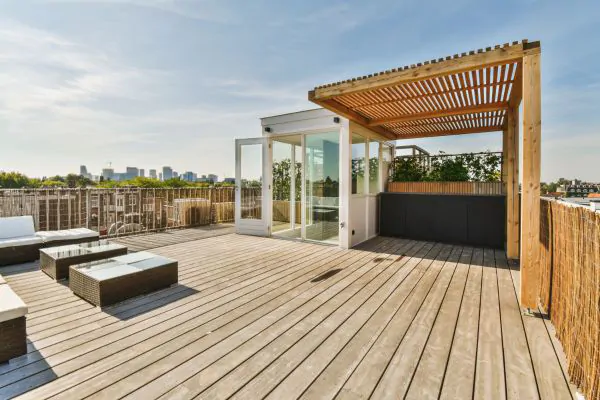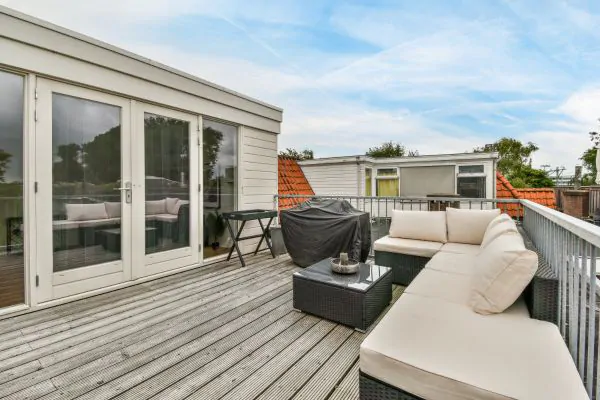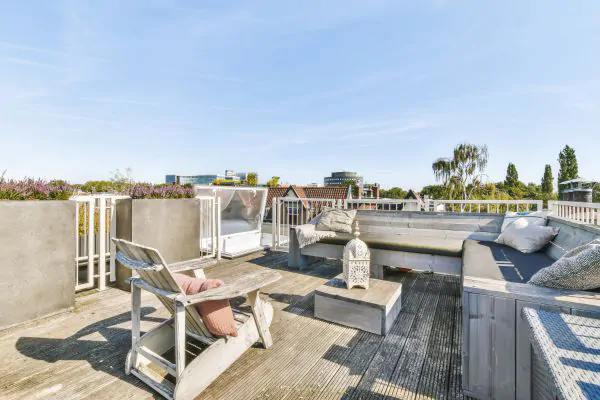In the urban landscape, rooftop decks emerge as oases of relaxation, offering homeowners a private slice of the open sky. However, transforming a rooftop into a deck requires meticulous planning and understanding of the structure’s capacity to support additional weight. Navigating local codes and ensuring proper waterproofing are vital steps toward realizing those rooftop deck ideas that float around in one’s imagination.
With the right guidance, constructing a deck on top of a roof morphs from dream to reality, creating a haven for unwinding or entertaining. Keep reading to discover the essential considerations and actionable steps to build a deck rooftop that endures and inspires.

Understanding Your Roof’s Structural Capacity
To build a deck on top of a roof, homeowners must first assess the structure’s weight-bearing capacity. Consulting a structural engineer is crucial to determine if the roof can support the additional load.
Evaluation involves scrutinizing blueprints, materials, and current conditions. Reinforcements like additional joists may be necessary. Understanding roof slope, drainage, and access points informs design. Building a rooftop deck requires attention to detail to create a durable outdoor space. Without proper analysis, disaster could occur. Emphasizing these elements ensures the deck serves as both an oasis above and maintains the integrity of the shelter below.
Local Building Codes and Permits
Securing the proper permits stands as an essential element when embarking on building a rooftop deck. Local building codes dictate specifics, from design and materials to safety railings, and adhering to these regulations is imperative. Failure to comply can result in fines or even enforced dismantling of an illegally constructed deck.

Homeowners must approach their local building department to obtain the regulations specific to rooftop deck construction in their jurisdiction. This process includes submitting detailed plans that comply with the local codes, often requiring the signature or stamp of a licensed professional. It’s not simply a bureaucratic hurdle but a step in ensuring the safety and legality of the home improvement project.
The review and approval of permits can vary significantly from one municipality to another, impacting project timelines. Navigating the complexities of such requirements calls for patience and meticulous planning. Homeowners are encouraged to engage with permitting processes early to avoid setbacks that could push back the enjoyment of their new outdoor space.
Waterproofing and Drainage Strategies
Building a rooftop deck hinges on a robust waterproofing and drainage system. Redirecting water away from the deck and underlying roof is crucial for longevity.
Selecting appropriate waterproofing materials and methods is essential, considering the rooftop’s conditions and expected foot traffic. Professional installation ensures protection against inclement weather.

Strategically placed drainage pathways prevent water pooling and potential damage. Innovative solutions, like built-in drainage, blend seamlessly into the deck’s design while efficiently channeling water away. Cutting corners risks costly water damage, highlighting the importance of meticulous design and construction in rooftop deck projects.
Choosing the Right Materials
Choosing materials for rooftop deck requires prioritizing durability and weather resistance. Options like pressure-treated lumber, composite decking, and tropical hardwoods offer resilience against harsh rooftop conditions.

Environmental considerations drive the choice towards sustainable materials, aligning with green building standards. Recycled or sustainably sourced wood combines eco-friendliness with durability. Integrating these materials reflects a commitment to environmentally responsible practices.
Aesthetic appeal is also vital, with material choices enhancing the property’s allure. Harmonizing with the building’s architecture creates a seamless transition from indoors to out, elevating the rooftop deck into a captivating retreat.
Texture and color selection further enhance the space, making it a visually stunning property addition.
You might like: Wood Vs. Composite Decking
Safety Measures for Rooftop Decks
Safety is paramount in building a rooftop deck, and handrail prevents falls. Built to code, they ensure a secure boundary.
Lighting is essential for visibility at night, strategically placed to illuminate pathways and enhance architectural features while promoting safety. Non-slip surfaces are vital, especially in adverse weather, offering traction and reducing the risk of accidents.
These details, from railings to lighting and flooring, ensure a secure and enjoyable rooftop deck experience. Building to code with sturdy railings provides a safe boundary without sacrificing aesthetics.
Thoughtful lighting placement enhances visibility, while non-slip surfaces offer traction in all conditions. These elements combine to create a secure and inviting rooftop oasis, day and night.
Professional Installation vs. DIY
The decision between professional installation and the do-it-yourself approach carries significant implications in rooftop deck construction, influencing the initial quality and long-term functionality.
Self-installation might offer upfront cost savings, but assessing factors such as accessibility and entry points, integrating green roofing elements, and optimizing lighting and aesthetics alongside practical maintenance insights ensures sustainable enjoyment of the rooftop.
Entrusting the project to seasoned professionals ensures that every detail, whether it’s the logistics of reaching the rooftop with materials or the finesse of incorporating vegetation without jeopardizing structural soundness, is meticulously executed.
An expert touch ensures that creative lighting solutions enhance the deck’s ambiance, and appropriate maintenance practices are established to preserve the integrity and beauty of the rooftop deck for years to come.
1. Accessibility and Entry Points
The question of how to build a roof deck is not only a matter of structural design but also of considering access routes for materials and people. Professional installers conduct site evaluations to identify viable entry points that minimize disruption and ensure safe, efficient transport of construction materials to the rooftop. A well-planned access strategy is key to a successful installation, as it affects everything from project timeline to worker safety.
2. Green Roof Considerations
When integrating green roof features into a rooftop deck, mindful consideration is given to the compatibility of vegetation with the deck’s structural components. Qualified professionals are adept at merging eco-friendly living spaces with recreational areas to ensure that plant selection, soil depth, and irrigation systems are thoughtfully incorporated without compromising the rooftop’s integrity or functionality.
3. Lighting and Aesthetics
The interplay of lighting with the aesthetic elements of a rooftop deck transcends mere functionality, setting the ambiance for the entire space. A professional’s approach to this facet of deck construction includes strategically selecting light fixtures that not only accent safety passages but also highlight key features of the deck, creating an inviting atmosphere that marries safety with sophistication. It is this harmonious blend of practicality and artistic vision that truly defines a professionally installed rooftop deck.
4. Maintenance Tips for Longevity
A rooftop deck’s endurance is heavily influenced by regular upkeep, which is an aspect that professionals never overlook. They impart crucial knowledge on proactive measures such as prompt clearing of debris and leaves, routine sealing and staining, or addressing small repairs before they escalate. This active approach to maintenance is fundamental for preserving a rooftop deck’s condition and ensuring its longevity.
Cost Estimation and Budgeting
Cost estimation and budgeting are just two of the critical rooftop deck construction details that shape the project’s scale and complexity. Obtaining quotes from contractors offers insight into financial requirements and guides decisions on building materials and design.
Professional assessments encompass labor, materials, permits, and potential modifications, providing a comprehensive view of costs. Strategic allocation of funds, considering both upfront and long-term expenses, ensures smooth progress without financial strain. Contingency budgeting is essential for unforeseen costs and safeguarding against project interruptions. This financial planning ensures the completion of a rooftop deck that meets functional needs and aesthetic desires, standing as a lasting addition to the home.
Consulting with Professionals
Partnering with seasoned experts is crucial for homeowners venturing into rooftop deck construction. These professionals guide the journey from planning to completion, ensuring technical precision and aesthetic appeal.
They offer invaluable insights into rooftop deck ideas and how to build a roof deck, translating concepts into stunning outdoor spaces. Architects, engineers, and contractors navigate the project, addressing load-bearing concerns and material compatibility.
This collaboration establishes a solid foundation for durability and safety. Selecting the right team ensures compliance with building codes and permits, culminating in a luxurious rooftop retreat. Their expertise in construction details, from waterproofing to material selection, ensures a rooftop deck that combines elegance with peace of mind.
With their guidance, homeowners can realize their vision and create a rooftop oasis that exceeds expectations.
Related Post: 5 Reasons To Hire A Professional Deck Builder
Conclusion
In conclusion, ensuring the proper planning and execution of a rooftop deck project is paramount.
It requires rigorous assessment of the roof’s structural capacity, strict adherence to local building codes, and careful selection of materials and waterproofing methods.
Safety measures, such as the integration of railings and non-slip surfaces, are essential for creating a secure environment.
Opting for professional installation over a DIY approach maximizes not only the deck’s potential but also makes sure that all technicalities, including accessibility and maintenance, align with the highest standards of construction.
A thoughtful budget that accounts for expected and unexpected costs enables homeowners to navigate financial implications expertly.
Consulting with professionals like All Pro Cape May Deck Builders at every stage ensures a harmonious melding of the deck’s form and function, resulting in a luxurious and enduring outdoor living space that enhances a home’s value and appeal.



